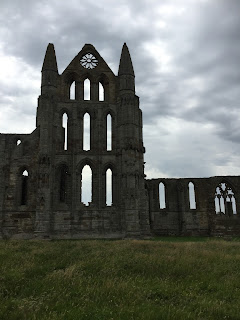Whitby Abbey is always worth a
visit. Dracula thought so, and who are we too argue. The only real drawback is
the 199 steps you have to climb to get there. In my view, if the Vikings had
the puff to ransack the Abbey after all that climbing, well good luck to them.
Good luck to them too for renaming the place, giving it a more sensible name.
Whitby. The original inhabitants, the Brigantes had called it Sinus Fari, which
brings to mind some kind of nose disease. The Saxons were even worse, calling
it Streonshalh, which is fine if they were naming it after a vigorous sneeze.
No, Whitby – Norse for White Settlement is a far superior name, though now it
might be seen as politically incorrect.
The Abbey was founded in 657 by
Oswy, the King of Northumbria and was shared by Monks and Nuns following the
Celtic tradition. In fact, its first ruler and driving force was a woman – St
Hilda.
In 664 AD we had the Synod of
Whitby – which is a bit of a misnomer for the Vikings hadn’t yet come to rename
the place. But thinking on it, the Synod of Streonshalh just doesn’t cut it.
The Synod of Whitby made a fateful decision in terms of which ‘Church’ the
North should follow – the loosely organised but spiritual Celtic Church, or the
prestigious bureaucracy of Rome. They chose the latter and three years later
the Vikings came and sacked the place.
Coincidence?
I think not.
The Abbey recovered in time,
flowered in the High Middle Ages and was all but destroyed by Henry VIII. It’s
final indignity occurred in 1914 when the Germans fleet shelled Whitby and
inadvertently or otherwise damaged much of the West Front.
To be honest, I found it hard to
stop taking pictures. The damned place is so photogenic, but anyway, here goes.
An Abbey and a UFO. What more do you want?
Apart from the fact it is in ruins, very much as the medieval traveller would have seen it.
St Mary’s, the church close by is
in far finer condition, and though dating from the C11th was comprehensively
besmirched late C18 Low Anglicans. It just gave me the creeps, all those boxed
pews - pens for sheep – and the three storied pulpit dominating those below,
and from which the word of God was preached. I found it oppressive and claustrophobic.
The day ended with a meal of fish
and chips on the quayside. No pictures of this, we were too busy fending off
predatory gulls. Quite honestly, Dracula would have been better served by gulls than bats. They strutted about in small predatory gangs, sensing the old
and infirm and making sudden swoops on the unguarded chip or fragment of fish.
Hitchcock had been to Whitby, I thought, and likely had lost a chip or two.












No comments:
Post a Comment